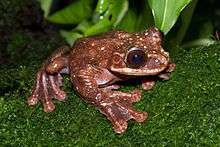Ecnomiohyla
Ecnomiohyla, commonly known as fringe-limbed treefrogs or marvelous frogs, is a genus of frogs in the family Hylidae.[2] This genus was erected in 2005 following a major revision of Hylidae. The ten original species in this genus (E. rabborum and E. sukia are later discoveries) were previously placed in the genus Hyla. The generic name Ecnomiohyla comes from Greek ecnomios ("marvelous" or "unusual") and Hylas, the companion of Hercules.[1][3][4]
| Fringe-limbed treefrogs | |
|---|---|
 | |
| Ecnomiohyla rabborum | |
| Scientific classification | |
| Kingdom: | Animalia |
| Phylum: | Chordata |
| Class: | Amphibia |
| Order: | Anura |
| Family: | Hylidae |
| Subfamily: | Hylinae |
| Genus: | Ecnomiohyla Faivovich et al., 2005[1] |
| Type species | |
| Ecnomiohyla miliaria Cope, 1886 | |
| Species | |
|
See text | |
Description
Members of Ecnomiohyla are moderately sized to very large frogs with distinctive scalloped fringes of skin on the outer edges of their limbs and relatively immense hands and feet. They are found in the canopies of wet forested highlands of southern Mexico through Central America to Colombia.[5] They are capable of gliding using their webbed hands and feet.[6]
Species
The genus currently includes 12 species,[2]
| Binomial name and author | Common name |
|---|---|
| Ecnomiohyla bailarina Batista, Hertz, Mebert, Köhler, Lotzkat, Ponce, and Vesely, 2014 | Golden-eyed fringe-limbed treefrog |
| Ecnomiohyla echinata (Duellman, 1961) | Oaxacan fringe-limbed treefrog |
| Ecnomiohyla fimbrimembra (Taylor, 1948) | Heredia treefrog |
| Ecnomiohyla miliaria (Cope, 1886) | Cope's brown treefrog |
| Ecnomiohyla minera (Wilson, McCranie, and Williams, 1985) | Guatemala treefrog |
| Ecnomiohyla phantasmagoria (Dunn, 1943) | |
| Ecnomiohyla rabborum Mendelson, Savage, Griffith, Ross, Kubicki, and Gagliardo, 2008 | Rabb's fringe-limbed treefrog (probably extinct, 2016) |
| Ecnomiohyla salvaje (Wilson, McCranie, and Williams, 1985) | Copan treefrog |
| Ecnomiohyla sukia Savage & Kubicki, 2010 | |
| Ecnomiohyla thysanota (Duellman, 1966) | Cerro Mali treefrog |
| Ecnomiohyla valancifer (Firschein and Smith, 1956) | San Martin fringe-limbed treefrog |
| Ecnomiohyla veraguensis Batista, Hertz, Mebert, Köhler, Lotzkat, Ponce, and Vesely, 2014 | |
See also
References
- Julián Faivovich; Célio F.B. Haddad; Paulo C.A. Garcia; Darrel R. Frost; Jonathan A. Campbell; Ward C. Wheeler (2005). "Systematic review of the frog family Hylidae, with special reference to Hylinae: phylogenetic analysis and taxonomic revision". Bulletin of the American Museum of Natural History. 294 (294): 1–240. CiteSeerX 10.1.1.470.2967. doi:10.1206/0003-0090(2005)294[0001:SROTFF]2.0.CO;2.
- Frost, Darrel R. (2014). "Ecnomiohyla Faivovich, Haddad, Garcia, Frost, Campbell, and Wheeler, 2005". Amphibian Species of the World: an Online Reference. Version 6.0. American Museum of Natural History. Retrieved 23 May 2014.
- Joseph R. Mendelson III; Jay M. Savage; Edgardo Griffith; Heidi Ross; Brian Kubicki; Ronald Gagliardo (2008). "Spectacular new gliding species of Ecnomiohyla (Anura: Hylidae) from Central Panama". Journal of Herpetology. 42 (4): 750–759. doi:10.1670/08-025R1.1.
- Charles W. Myers; Richard B. Stothers (2006). "The myth of Hylas revisited: the frog name Hyla and other commentary on Specimen medicum (1768) of J. N. Laurenti, the "father of herpetology"". Archives of Natural History. 33 (2): 241–266. doi:10.3366/anh.2006.33.2.241.
- Jay M. Savage; Brian Kubicki (2010). "A new species of fringe-limb frog, genus Ecnomiohyla (Anura: Hylidae), from the Atlantic slope of Costa Rica, Central America". Zootaxa. 2719: 21–34.
- Robert W. Hansen, ed. (2008). "About our cover: Ecnomiohyla rabborum". Herpetological Review. 42 (1): 3.
External links
- AmphibiaWeb: Information on amphibian biology and conservation. [web application]. 2008. Berkeley, California: Ecnomiohyla. AmphibiaWeb, available at http://amphibiaweb.org/. (Accessed: Apr 21, 2008).